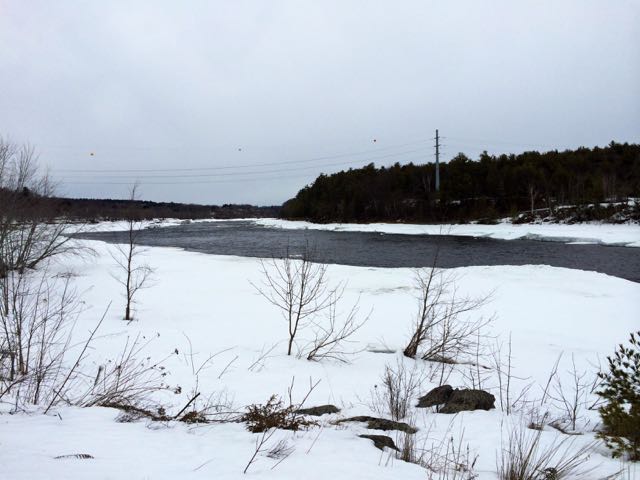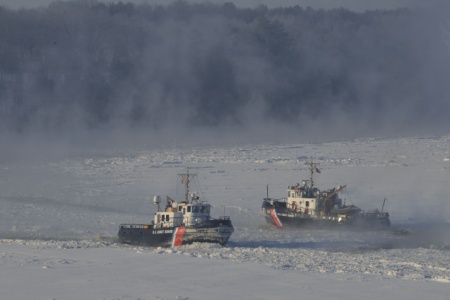
Ice-out on the Penobscot
This time of year, many eyes are on Maine’s rivers, lakes, and harbors, watching for the spring phenomenon known as ice-out. On rivers in particular, ice-out brings the risk of flooding.
On Thursday, the National Weather Service Caribou Office issued a flood potential outlook statement. In central Maine, which includes the lower Penobscot River, and interior downeast Maine, risk of flooding due to ice jams is above normal, with risk decreasing in the north. Coastal waterways have lost much of their ice.
In the case of the Penobscot River, conditions are different now that the Penobscot River Restoration Trust has removed the two lowermost (most seaward) dams at Great Works and Veazie. The Veazie Dam created a four-mile impoundment of slow-moving water, leading to the formation of large sheets of ice, which broke apart when they moved over the dam. But as a “run of the river” facility, Veazie Dam had no capacity for actively regulating water or ice. Now, the river at Veazie is shallower and faster (see photo at left). Instead of a solid sheet of ice, a persistent dark ribbon of open water flows down the middle of the rocky channel. The bridges in Bangor act much the same way, helping to break up large pieces of ice.
In 2008, the Army Corps of Engineers studied the effects of the Veazie and Great Works dam removals on ice dynamics in the Penobscot River. Engineer Andrew Tuthill of the Ice Engineering Research Group, based in Hanover, New Hampshire, researched historic ice events on the Penobscot and Piscataquis rivers, and analyzed water and weather factors influencing ice jam formation.
Bangor’s worst ice jam floods occurred in 1846 and 1902. Both resulted from mid-December freshets that cleared the upper river of ice, followed by cold that produced large volumes of frazil ice (loose, elongate crystals). High flows carried the slush past the dams (and there were more dams on the lower river in 1902), forming a major ice jam in the lower river. In March of both years, a dynamic breakup of ice ran into the jam and flooded downtown Bangor. Though no lives were lost and the city recovered quickly, the 1846 and 1902 ice jam floods were economically devastating, according to the Army Corps analysis. Both floods occurred with multiple dams in place and little to no ice-breaking in the lower river.

The U.S. Coast Guard began ice breaking operations on the Penobscot in the 1940s, preventing the formation of frozen ice jams during the winter and providing an unobstructed path for ice-out in the spring. Record-cold temperatures this winter created an unusually thick ice cover on the Penobscot River, up to two feet in some places. According to the Coast Guard, ice tends to accumulate just below the confluence of the Kenduskeag Stream and Penobscot River, at the bend in river south of Cianbro, Crosby Narrows, Snub Point, Bald Hill, Bucks Ledge, and Oak Point. The 140-foot Rockland-based cutter Thunder Bay, along with 65-foot Rockland-based cutter Tackle and Southwest Harbor-based cutter Bridle took part in ice-breaking operations this year. (Here’s a YouTube video by Monty Rand photography.)
The Army Corps reviewed the effects of Penobscot River dams on river ice processes, past and present, and modeled worst-case-scenario conditions for ice formation, with and without the dams.
Instead of forming separate jams, frazil ice could form a longer single ice jam at the beginning of the freeze in the lower river instead of above Veazie, but otherwise ice jam potential did not appear to be worse post dam removal.
Despite this winter’s cold, long-term temperature records show a gradual warming since 1894, which may have reduced the ice jam flood potential at Bangor, according to the Army Corps. The river has also become more variable in terms of flow speed and volume, making natural mid-winter breakups more common, although that didn’t happen this year.
The Maine River Flow Advisory Commission meets every year, beginning in late winter, to review the flooding potential of Maine’s waterways. The Commission includes Coast Guard Sector Northern New England, Maine Emergency Management Agency, the National Weather Service, and the U.S. Geological Survey, as well as other state and federal agencies. According to their latest report, dated March 19, spring flood potential is normal. Rainfall is the major driver of flooding in the Penobscot; snowpack, frozen ground and river ice create additional risk factors. For example, the flood of record (in 1987) was not associated with ice.
“The Corps report is about changing dynamics and contributing factors to ice-related flooding, but is not to be used as a predictive tool. We might some day see a situation—winter temperatures, ice thickness and river flow—that doesn’t have a historical corollary, dams or no dams,” said Matt Bernier, Fisheries Habitat Restoration Specialist with NOAA’s Restoration Center in Orono, Maine, who has been working on the Penobscot River Restoration Project.
“The sides of the river are breaking up, however the center of the river is still solid. The slush underneath the river ice is for the most part gone. We should experience significant movement,” said Richard Okulski of the National Weather Service in Caribou. With temperatures again turning colder, some refreeze is possible, although rain and warmer temperatures are expected later this week
So, will the river flood or not? As always, it all depends on the weather.
